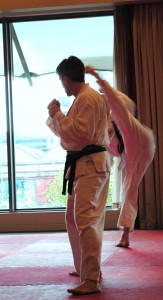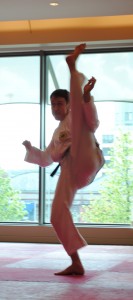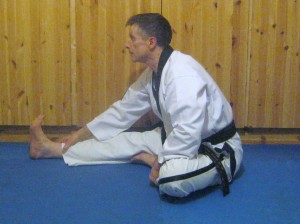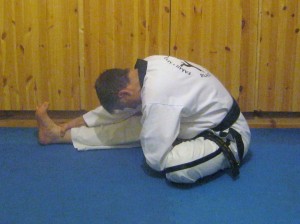Why Flexibility Training is Important for Taekwondo & Health
Every fitness book will tell you that it is vital to stretch regularly to maintain flexibility and aid muscle recuperation throughout your life. They are all right. I took awhile to heed this great advice, I needed stronger reasons although role models were plentiful.
 When I first saw a Taekwondo exhibition, in Cork’s City Hall in June 1974, it was lead by Master Ki Ha Rhee and members of the Republic of Ireland Taekwondo Association. Here men could kick their legs up to head height and spar throwing high kick after high kick. My initial reaction was both amazement and disappointment. Amazed because of the sheer artistic beauty of the kicks and disappointed because I knew it would be a challenge for me to get my head around stretching.
When I first saw a Taekwondo exhibition, in Cork’s City Hall in June 1974, it was lead by Master Ki Ha Rhee and members of the Republic of Ireland Taekwondo Association. Here men could kick their legs up to head height and spar throwing high kick after high kick. My initial reaction was both amazement and disappointment. Amazed because of the sheer artistic beauty of the kicks and disappointed because I knew it would be a challenge for me to get my head around stretching.
Stretching in yoga positions for long periods, while struggling to relax and concentrate on each stretch, and having a handle on some Sanskrit vocabulary did nothing for my popularity as a teenager. Such was my resistance to it that it took me about seven years, and countless injuries to give stretching the attention it deserves. I began training in Taekwondo in 1974 and I only really got into taking stretching seriously when in 1981, Tommy Barry from Waterford who was with me on the Irish ITF Team in Argentina explained the value of stretching. He fitted it into his work and family life as much as possible, he had even devised a number of stretches using a chair, and twice weekly he would do a longer session of stretching and slow kicking drills. He was one of the few guys doing weight training as well, and his Boxing was great so I took on board his advice and he gave me a stronger reason to make more of a commitment to stretching.
 All kicking techniques require flexibility, dexterity and mobility of the joints in particular the hip joint. Stretching is almost an art in itself and promotes suppleness stamina and strength. It is a key component of fitness. Depending on your genetics and body type, to master any degree of kicking ability get to like stretching. A minimum of just 20 to 30 minutes a day will be enough to get a good level of flexibility, unless you have some challenge physically. Apart from the stretching that you will get in a martial arts class, stretching is an activity that can be squeezed into your lifestyle, but you must make a small daily effort and discipline to fit it in. You can stretch any time, on your own or with the aid of a partner. Stretching is great for recuperation after injury and helps to counter stress, release any tension in your body and induce relaxation.
All kicking techniques require flexibility, dexterity and mobility of the joints in particular the hip joint. Stretching is almost an art in itself and promotes suppleness stamina and strength. It is a key component of fitness. Depending on your genetics and body type, to master any degree of kicking ability get to like stretching. A minimum of just 20 to 30 minutes a day will be enough to get a good level of flexibility, unless you have some challenge physically. Apart from the stretching that you will get in a martial arts class, stretching is an activity that can be squeezed into your lifestyle, but you must make a small daily effort and discipline to fit it in. You can stretch any time, on your own or with the aid of a partner. Stretching is great for recuperation after injury and helps to counter stress, release any tension in your body and induce relaxation.
Many of us are aware of the general benefits of stretching particularly for improvement of performance when kicking. Probably a little more unknown are the effects of deep stretching on your core and pelvic area, and how stretching helps maintain and prolong digestive and urinary tract health. The deep muscles in these areas house many important organs such as the intestines, colon, kidneys and bladder, and therefore have a direct impact on their functionality and health.
After training a few years you may feel you hit a plateaux, so you need to readjust your routine every few months. Another thing to remember is that in most classes your instructor can only place a certain amount of time on stretching, so the holding positions will be only for 20 or 30 seconds maximum. Try not to have this time as a guide to deeper stretching as holding a stretch for a longer period of time is far more beneficial. When you’re not in class and training on your own, do place more time into your stretches, at least 60 seconds per stretch. It is natural to tend to favour some stretches over others, because they feel more comfortable to us, and while this is a good thing, try and do the ones that perhaps are not covered in class. This can be overcome by holding the positions longer, or making sure your alignment is aiding the stretch.
Just a final word on avoiding injury. I would definitely recommend partner stretching, BUT on this condition, and this is important, that you work with a partner who knows your limitations and perhaps trains with you regularly. If you lie with your back on the floor and offer your partner your leg so he/she can stretch your hamstring, this is good, but be careful of the amount of pressure applied and ensure you communicate clearly with each other. If you don’t have the benefit of a training partner, perhaps you can use the aid of a skipping rope or belt.
 Remember to breath in as you prepare to stretch and breath out as you execute the stretch. Breath normally and relax as much as possible as you hold the stretch.
Remember to breath in as you prepare to stretch and breath out as you execute the stretch. Breath normally and relax as much as possible as you hold the stretch.
I hope you find this blog useful and once again, any feedback would be welcome. Train hard and keep healthy.
Frank Murphy





Hi Frank, Nice article again, I agree particularly on using a belt and how helpful that can be. Aidan (Walsh) has moved on to Ashtanga Yoga recently and is enjoying the challenge of this different type of Yoga. It was recommended to us by the cuban boxing coach Nicolas Cruz. So if you can remember any of your sanskrit from all those years ago, give it a try if you get the opportunity.